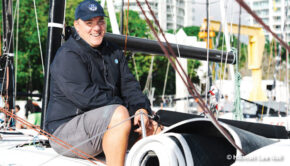The Doyle Dynamic
Published on May 24th, 2016
Cut from the cloth of old-school sailmaking, Robbie Doyle has evolved to become one of the most technical sailmakers of his generation. Gary Jobson provides this report for Sailing World…
By the time Doyle finished his freshman year at Harvard in the late 1960s, he’d won the Sears Cup twice and the North American Solo Championship, and was an alternate on the U.S. Olympic sailing team, an All-State basketball player in Massachusetts, an All-American sailor, a top swimmer and a strong tennis player.
As a top student as well, he thought he was destined for medical school, but sailing somehow kept getting in the way. Modern medicine’s loss would eventually be sailing’s gain, for from the mind of the brilliant sailor from Marblehead came great innovation and even greater success.
In 1974, Ted Turner drafted Doyle, only 24 years old at the time, for the unsuccessful America’s Cup defender trial with Mariner. The boat was seriously off the pace, but once dispatched from the competition, Doyle was invited by the Courageous Syndicate to help develop its sails. Courageous defended against Australia’s Southern Cross, and three years later, Doyle joined Turner again, this time aboard Courageous.
It was here, in 1977, that I sailed alongside the man with shoulders as broad as his smile, and where I quickly learned what made him unique. He’s highly intelligent and methodical in his sailing, seeking technical improvements through trial, error and careful analysis. With Doyle, the science has always been the art.
Doyle’s early mentors included Ted Hood and MIT’s Dr. Jerome Milgram, a design contributor to more than eight America’s Cup syndicates. Both Hood and Milgram influenced Doyle’s fascination with design efficiency.
“Milgram was a pioneer,” says Doyle. “He raised the level of scientific analysis of yacht racing. He came up with the idea of testing sails in a water tank. Unfortunately, the water made the sails change shape due to softening the resin, but it was an interesting test, and from that we did learn how to design a faster shape.”
After winning the America’s Cup with Courageous, Doyle returned to Hood Sails and immediately went to work helping Cornelis “Connie” van Rietschoten with his inventory for Flyer in the Whitbread Round the World Race. Van Rietschoten won in 1978 and again in 1982. One of the breakthrough design elements at the time was the use of a hydraulic mast jack to adjust rig tension, equipment now standard on grand-prix boats.
“The concept came out of discussions we had at a pub in Marblehead,” says Doyle. “Connie told me that they could not easily loosen the rig during the stopover in Cape Town. That’s when we came up with the idea of putting a hydraulic ram under the mast.” – Full report









 We’ll keep your information safe.
We’ll keep your information safe.